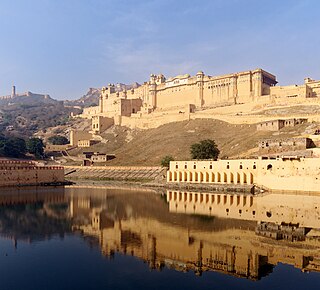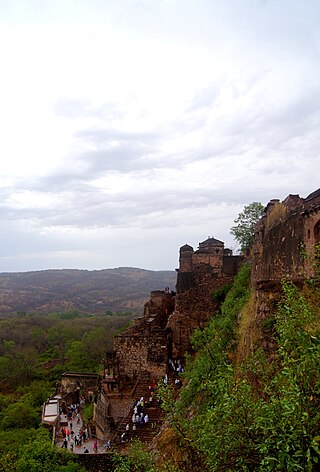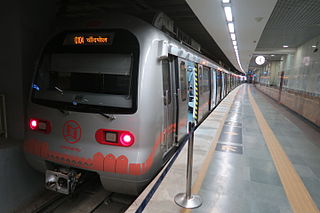
Jaipur is the capital and the largest city of the north-western Indian state of Rajasthan. As of 2011, the city has a population of 3.1 million, making it the tenth most populous city in the country. Located 268 km from the national capital New Delhi, Jaipur is also known as the Pink City due to the dominant color scheme of its buildings in old city.

The Kachhwaha, or Kachhawa is a Rajput clan found primarily in India.

Amer Fort or Amber Fort is a fort located in Amer, Rajasthan, India. Amer is a town with an area of 4 square kilometres (1.5 sq mi) located 11 kilometres (6.8 mi) from Jaipur, the capital of Rajasthan. Located high on a hill, it is the principal tourist attraction in Jaipur. Amer Fort is known for its artistic style elements. With its large ramparts and series of gates and cobbled paths, the fort overlooks Maota Lake, which is the main source of water for the Amer Palace.

Jaipur International Airport is an international airport serving Jaipur, the capital of Rajasthan. It is located in the southern suburb of Sanganer, which is located 13 km (8.1 mi) from Jaipur. It is the 13th busiest airport in India in daily scheduled flight operations.

Jaigarh Fort is situated on the promontory called the Cheel ka Teela of the Aravalli range; it overlooks the Amer Fort and the Maota Lake, near Amer in Jaipur, Rajasthan, India. The fort was built by Mirza Raja Jai Singh in 1726 to protect the Amer Fort and its palace complex and was named after him.

Nahargarh Fort stands on the edge of the Aravalli Hills, overlooking the city of Jaipur in the Indian state of Rajasthan. Along with Amer Fort and Jaigarh Fort, Nahargarh once formed a strong defence ring for the city. The fort was originally named Sudershangarh, but it became known as Nahargarh, which means 'abode of tigers'. The popular belief is that Nahar here stands for Nahar Singh Bhomia, whose spirit haunted the place and obstructed construction of the fort. Nahar's spirit was pacified by building a temple in his memory within the fort, which thus became known by his name.

Ranthambore Fort lies within the Ranthambore National Park, near the city of Sawai Madhopur in Sawai Madhopur district of Rajasthan, India. the park being the former hunting grounds of the Maharajahs of Jaipur until the time of India's Independence. It is a formidable fort having been a focal point of the historical developments of Rajasthan. The fort is believed to be constructed by numerous kings from several dynasties including The jats, Chahamana Rajputs, Hada Rajputs, Mewar Rajput Kings and then the Delhi Sultanate captured it for a brief time. The fort provides a panoramic view of the surrounding Ranthambore National Park and is now a popular tourist attraction.

The Rambagh Palace in Jaipur, Rajasthan is the former residence of the Maharaja of Jaipur located 5 miles (8.0 km) outside the walls of the city of Jaipur on Bhawani Singh Road.

Birla Mandir, Jaipur is a Hindu temple located in Jaipur, India and is one of many Birla mandirs. It was built by the B.M. Birla Foundation in 1988 and is constructed solely of white marble. It is dedicated to the Hindu goddess Lakshmi and god Vishnu (Narayan), whose images appear inside, along with other Hindu gods and goddesses and selections from the Gita and Upanishads. It is located in Jaipur's Tilak Nagar neighborhood near Moti Dungari hill.
Idgah railway station is in Idgah colony in the southwest of the city of Agra, Uttar Pradesh, India. Idgah railway station serves around 75,000 passengers every day.

The Jaipur Metro is a rapid transit system in the city of Jaipur, Rajasthan, India. Construction on the mostly elevated part of the first line, called Phase 1A, comprising 9.63 kilometres (5.984 mi) of route from Mansarovar to Chandpole Bazaar, started in November 2010, and was completed in 2014. The Jaipur Metro began commercial service between Chandpole and Mansarovar on 3 June 2015. The Jaipur Metro Rail system is India's sixth metro rail system after those in Kolkata, Delhi, Bangalore, Gurugram and Mumbai. The Jaipur Metro is the first metro in India to run on triple-storey elevated road and metro track. Phase 1-B, from Chandpole to Badi Chaupar, began operation on 23 September 2020.

The Albert Hall Museum in Jaipur is the oldest museum of the state and functions as the state museum of Rajasthan, India. The building is situated in Ram Niwas garden outside the city wall opposite New gate and is a fine example of Indo-Saracenic architecture. It is also called the Government Central Museum. It was considered one of the best 19th century museums for the variety of its collections. It was renovated in 2008 and reopened as one of the most advanced museums in India.
Jaipur Junction is a railway station in Jaipur, the largest city of the Indian state of Rajasthan. It serves the Capital City of Rajasthan. This station serves as the headquarters of the Jaipur Railway Division and the North Western Railway zone of the Indian Railways.
The Battle of Bhopal was fought on 24 December 1737 in Bhopal between the Maratha Confederacy and the combined army of the Nizam and several Oudh generals in which Marathas under Bajirao I were victorious.

Nareli Jain Temple or Shri Gyanodaya Tirth Kshetra, is a new Jain temple located on the outskirts of Ajmer 7 kilometers from the city center and 128 kilometers west of Jaipur on the main national highway 8.

Sawai Madhopur Junction railway station is a major railway station on New Delhi–Mumbai main line and Jaipur–Mumbai rail line of the West Central Railway zone network. It is very well connected to Hazrat Nizamuddin, Mumbai Central, Jaipur Junction, Bharatpur, Mathura, Kanpur Central, Delhi, Bikaner, Chittaurgarh, Kota Junction.

Moti Dungri is a Hindu temple complex dedicated to Lord Ganesha in Jaipur, Rajasthan. It was built in 1761 under supervision of Seth Jai Ram Paliwal. The temple is a popular tourist attraction in the city and is located next to the Birla Temple.













